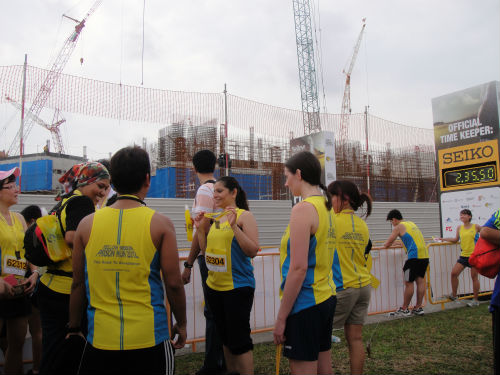
Having cramps when running is one of the worst nightmares of a runner. One moment, you may be going well and on course to make a new personal best. But then the next minute, it hits you and completely throws your training run or race off tangent.
Cramps aren’t simply just a nuisance though. Sometimes they may also lead to other problems such as muscle injuries, which can put you out of commission for several days or even weeks.
Here are some tips to prevent cramps when running.
Drink lots of fluids
One of the reasons why people get cramps when running is because they aren’t drinking enough liquids. When you are running, you lose liquids through sweating, so replenishing this both during and after your run is very important.
To prevent cramping, a good amount of fluids to drink would be 150 to 350 mls for every 20 minutes of running. Water is usually the best liquid to take in, but if your exercise session is going to last longer than 45 minutes, water alone won’t be sufficient. You will need isotonic drinks too, to replace the salts and electrolytes in your body.
Keep your pace constant
Maintaining a pace that you are comfortable with, helps to prevent cramps when running. So don’t try to be too ambitious and run at a pace much faster than your body’s comfort levels. This is one of the reasons why runners tend to hit a wall, get cramps and struggle to continue, during the latter stages of a long-distance race. Running at a much faster pace than your body can take, will possibly increase your chances of getting cramps, especially in the legs.
Do not run when it is too hot
When the heat is intense, for example, at noon during the hotter weather, do not go out for a run. This is because when the temperature is very hot, you will lose liquids at a much faster rate than you can replenish – and you may then get cramps.
Some runners may think that going out for training runs when it is hot would help them, because they would then find it much easier on race day itself. But don’t make this mistake – it may lead to intense cramps.
Instead, the best times to go out for training runs, would be in the early mornings and evenings, when the weather is cooler.
Do not forget to stretch
You may think that doing warm up and cool down exercises is a complete waste of time, but it’s not. It helps to prevent those horrible cramps.
The muscles that you should stretch, in particular, would be those that you use a lot of, during the run. These are the muscles at the calves, quad and hip areas, because these are usually being contracted during your run. So stretching them would help to reduce your risk of getting a cramp.
Use suitable shoes
Make sure that you have the right running shoes, if you want to reduce your risk of having cramps when running. This is because if your shoes don’t fit you properly, it will increase the amount of stress you are exerting on your muscles and tendons – thereby increasing your chances of getting cramps. To choose the right shoes for your running style and gait, you should consult a specialist running shop.
Watch your diet
Your diet and nutrition plays a very important role in preventing cramps when running. For a start, cut down on your caffeine content, because caffeine makes the muscles get dehydrated more easily.
Also, try not to eat meals that are high in fat and proteins if you know that you are running about four to five hours later, because these take longer for the body to digest. As a result, your muscles will be trying to digest the food, as well as helping you to run. They will be overworked, and therefore, you will get cramps.
On the other hand, a great cramp-preventing food is bananas, because of their high potassium content. Potassium is great for muscle repair and recovery too and helps to keep your muscles in smooth working order to prevent cramps when running.
Related Blog Posts:
- How To Run Faster
- Train For A Marathon
- Are you Ready to Run A Marathon
- Training For Half Marathon
- Waking up Early to Run
- Life Lessons Learned From Running

Leave a Comment